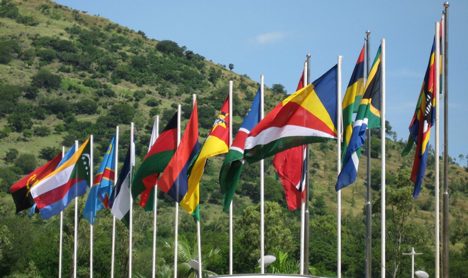Regional integration, security, macroeconomic stability and others formed the major issues discussed when Southern African leaders gathered late June in Maputo, Mozambique.
They were in the country for the extraordinary summit of Heads of State and Government organized by the Southern African Development Community (SADC).
The event was primarily called to review progress made in the implementation of the theme of the 40th SADC Summit; SADC: 40 Years Building Peace and Security, and Promoting Development and Resilience in the Face of Global Challenges, which was earlier endorsed by the SADC Summit in August 2020.
The first SADC Business Forum featured prominently as part of the comprehensive agenda, and other significant issues discussed included regional integration, cooperation and development.
The topic that got special attention was regional security and its possible impact on business and investment climate, with a particular focus on Mozambique and from broader perspectives, as a whole in southern Africa.
Under the Chairperson of SADC and the Extraordinary Summit, President of the Republic of Mozambique, Filipe Jacinto Nyusi together with 15 leaders from Southern Africa, finally, after several months of go-forth and back negotiations agreed to form a regional Standby Military Force.
The sources of funding for the force made up of a contingency fund and contributions from the Member-States that participate in the force, which should contribute between themselves with $7 million (€5.8 million).
While multiple barriers including high tariffs, customs rules and pitfalls on border-crossing with stocks still remain and hamper regional economic integration, Mozambican President Filipe Nyusi, in a speech, reaffirmed commitment to turn SADC into an example of regional integration, taking into account its geostrategic position and the existing energy potential.
Mozambican leader, during the Public-Private Dialogue and Business Forum, urged speeding up the ratification of protocols essential to economic integration.
The establishment of a customs union that evolves into a single market and monetary union is still a huge challenge. It delays the process of ratifying protocols on regional trade. The imbalances that characterize each of the states, such as great differences in macroeconomic stability, uneven levels of industrialization, lack of complementarity in the structure and production base and inefficiencies in the value chain.
Comparing all regional economic blocs in Africa, SADC seems unique but it is critical to fast-track reforms for a better business environment and macroeconomic stability, which are indispensable for attracting foreign investment to the regional bloc. Thus, the SADC Business Forum was, purposely held to bring together initiatives and projects, and match synergies to create opportunities.
Agostinho Vuma, the President of the Confederation of Economic Associations of Mozambique (CTA), has acknowledged, over the years, that tariff and non-tariff barriers are an obstruction to economic integration in southern Africa. There are so many challenges, such as the prevalence of tariff and non-tariff barriers, that stand as roadblocks to regional integration, according to Agostinho Vuma.
On the other hand, low production capacity and prohibitive interest rates imposed by banks weaken economic development and regional integration.
Some reforms are practically needed, that are conducive to the strengthening of private sector companies in southern Africa and that could drive the rapid integration of the region’s economies in a future free trade area, and that could attract foreign investors to strategic sectors in the region, he explained taking his turn at the podium.
The SADC Business Forum also debated the socio-economic impact of COVID-19 and post-pandemic recovery strategies, infrastructure and regional corridor development. Industrialization focused on improving the balance of trade within the countries of the region, the role of the energy and mineral resources sectors and the participation of national business in megaprojects were discussed.
Domestication of the SADC Industrialization Strategy with a Focus on Improving the Trade Balance. The session, moderated by Ciyong Zou, UNIDO Program Director, drew many participants who reviewed the processes on the integration and popularization of the strategy by the private sector.
Infrastructure: Development of SADC Regional Corridors. The participants here reviewed regional transport corridors that support the trade and regional integration agenda and further focused on interventions needed to form structures and attract investments. The establishment of the SADC Regional Development Fund in 2015 aims at mobilizing funds for key infrastructure and industrialization projects.
Industrialization remains SADC main economic integration agenda since April 2015, when the SADC Industrialization Strategy and Roadmap 2015-2063 was approved. The Vision 2050 is also premised on three inter-related pillars, namely industrial development and market integration; infrastructure development in support of regional integration; and social and human capital development.
In order to make entrepreneurship an asset in the collective structure of the region, the discussion panels share, reflect and promote the existing regional dynamics and good practices, with a global impact on the ecosystem and initiatives for the development of entrepreneurship.
Energy, Mineral Resources and the Local Content Value Chain; Agribusiness: promoting and linking regional reference value chains; Entrepreneurship in SADC: Ecosystem and Development; Socio-economic impact of COVID-19 in the region and recovery strategies. The participants looked at the challenges imposed by the Covid-19 pandemic, and what needs to be done as recovery pathways in the strategic regional sector.
Zimbabwe, through ZimTrade, show-cased its trade and investment opportunities. It related to the realization of its foreign policy objectives, particularly the development and integration agenda, according to Zimbabwe Chronicle.
The SADC region, with a market of 350 million consumers, seeks to leverage the existing potential, to raise trade and investment within the region, and within Africa and to the outside world.
Statistics on various economic areas are difficult to obtain. Nevertheless, the SADC Secretariat in an email told this research writer that in 2018, SACD’s total exports amounted to $154 billion and the total imports were $149 billion.
The SADC comprises 16 states: Mozambique, Angola, South Africa, Botswana, Zimbabwe, Eswatini, Democratic Republic of Congo, Lesotho, Madagascar, Malawi, Mauritius, Namibia, Seychelles, Tanzania, Zambia and Comoros.
Within its framework, the bloc collectively seeks to promote sustainable and equitable economic growth and socio-economic development, forge deeper cooperation and integration, to ensure good governance and durable peace and security, so that the region emerges as a competitive and effective player in the southern region, in Africa and the world.










